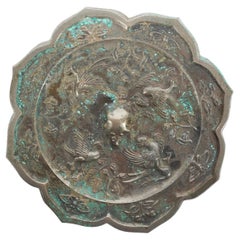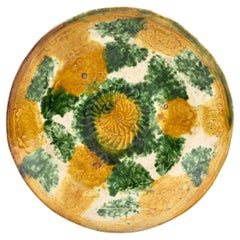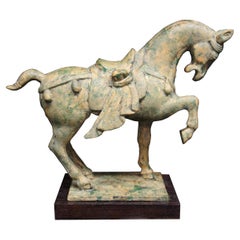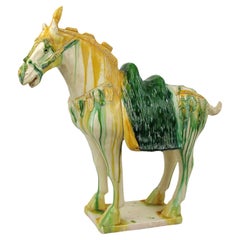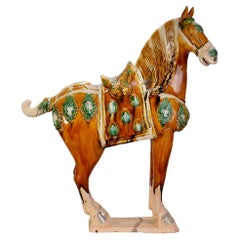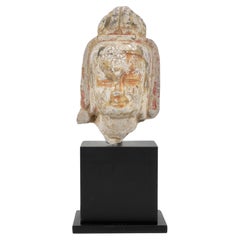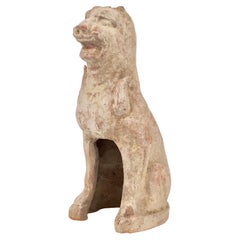Tang Asian Art and Furniture
13
117
1
to
19
80
12
118
118
118
809
462
188
183
159
84
63
55
40
24
22
21
21
14
13
13
12
9
80
6
31
1
1
10
7
1
1
83
39
30
16
14
112
111
103
7
1
3
Style: Tang
Large Chinese Ceramic Tang Horse
Located in Troy, MI
Circa 2010 Chinese ceramic Tang horse stands just under 28” tall. Colorful glaze in rich shades of amber, green and cream. Unknown maker. Very good preowned condition with no flaws f...
Category
2010s Chinese Tang Asian Art and Furniture
Materials
Ceramic
Stone Head of Bodhisattva, Northern Wei-Tang Dynasties
Located in seoul, KR
The face with downcast eyes and a smile, the hair swept up behind the pendulous ears into a high topknot. Faint traces of pigmentation hinting at the sculpture's original polychromy....
Category
15th Century and Earlier Chinese Antique Tang Asian Art and Furniture
Materials
Limestone
Sancai-glazed ‘floral’ dish, Liao dynasty(916~1125)
Located in seoul, KR
Well potted with shallow sides rising from a short foot, the interior molded with a single chrysanthemum surrounded by peony blossoms picked out in yellow and with green leaves again...
Category
15th Century and Earlier Chinese Antique Tang Asian Art and Furniture
Materials
Pottery
Large SanCai Glazed Pottery Horse Statue Chinese Tang Dynasty Style
Located in Bochum, NRW
Chinese Tang Sancai-glazed pottery statue of a horse standing on all four legs atop a rectangular base. The horse is decorated with bells and flowers. A traditional green saddle comp...
Category
Mid-20th Century Chinese Tang Asian Art and Furniture
Materials
Terracotta
Japanese Imperial Tang Dynasty Style Cast Bronze Horse Figure Statue Sculpture
Located in Dayton, OH
Mid 20th Century Tang Dynasty style Horse Figure. Made from Cast bronze with lovely patina. Comes with wooden stand. Marked Japan along the base.
Dimensions:
12" x 4.5" x 10.25"
(L...
Category
Mid-20th Century Tang Asian Art and Furniture
Materials
Bronze
Guardian Haitai Lion Pottery Figure, Northern Wei-Tang Dynasties
Located in seoul, KR
This figure represent a guardian haitai. The style of the figurine, with its facial features and remnants of paint, suggests it could be a part of funerary art, which was common in C...
Category
15th Century and Earlier Chinese Antique Tang Asian Art and Furniture
Materials
Pottery, Stoneware
Two Chestnut-glazed Pottery Figure of Sacred Bulls, Tang Dynasty
Located in seoul, KR
Naturalistically modelled, standing on a rectangular base with head facing forward and short tail curled to one side, incised details and covered overall in a rich chestnut glaze sav...
Category
15th Century and Earlier Chinese Antique Tang Asian Art and Furniture
Materials
Pottery, Stoneware
Sancai-Glazed ‘Floral’ Dish, Liao Dynasty(916~1125)
Located in seoul, KR
Well potted with shallow sides rising from a short foot, the interior molded with a single chrysanthemum surrounded by peony blossoms picked out in amber and with green leaves agains...
Category
15th Century and Earlier Chinese Antique Tang Asian Art and Furniture
Materials
Pottery, Stoneware
Antique, Rare & Decorative Pair of Hand Carved and Hand Painted Horse Sculptures
Located in Lisse, NL
Stunning and unique pair of matching horse sculptures.
With a combined experience of almost 30 years in the antiques trade, we were thrilled to once again find beautifully hand-crafted and decorative antiques that we had never seen before. From the density and the weight we can see and feel that these highly decorative horse sculptures are made of a tropical hardwood. Like, for example, with antique mirror frames or church sculptures these horses too were first covered with a mixture of chalk and glue so that the paint would hold longer. And, as so often is the case with antiques, the colors that were used for painting these horses are so much more beautiful than anything you find in this day and age that they truly are an absolute joy to look at. From the colors, the wear, the materials and the techniques that were used to create these horses we can see that these are 19th century antiques. However and unfortunately we lack the knowledge to be able to tell you from which country these highly decorative and sizeable works of art originate. We just can't find matching style horse sculptures anywhere on the worldwide web. They could be Chinese or Nepalese, but they could also be Persian or Arabian. We just have not been able to find out. What we do know is that they are definitely antique, they are in beautiful condition (with some wear, consistent with their age), they are highly decorative, probably unique and they have a look and feel that will instantly change the atmosphere of the room they are in.
Mind you, our sharp price for this wonderful pair of horse sculptures...
Category
Mid-19th Century Chinese Antique Tang Asian Art and Furniture
Materials
Wood
Important chinese terracotta sculpture of a camel, China Tang dynasty
Located in Saverne, Grand Est
Mingqi in grey terracotta with white slip and polychromy, representing a Bactrian camel, ridden by a court lady.
Good condition.
Please note that all ancient Chinese terracotta sculp...
Category
15th Century and Earlier Chinese Antique Tang Asian Art and Furniture
Materials
Terracotta
Belitung ship, Large Changsha bowl with plant patterns, Tang Period
Located in seoul, KR
The edges have been dipped in four places with brown, probably iron-oxide. The well of the bowl is freely painted in green and coffee coloured brown.
Period : Late Tang Dynasty
Prod...
Category
15th Century and Earlier Chinese Antique Tang Asian Art and Furniture
Materials
Pottery
Changsha Ewer, Tang Dynasty
Located in seoul, KR
It features two small lug handles on either side of the neck and a spout opposite the main handle. This ewer might have been used for wine or other liquids, which were poured through...
Category
15th Century and Earlier Chinese Antique Tang Asian Art and Furniture
Materials
Pottery, Stoneware
Chinese statuette of a horse
Located in EL CAMPELLO, ES
ITEM: Statuette of a horse
MATERIAL: Pottery
CULTURE: Chinese, Tang Dynasty
PERIOD: 618 – 907 A.D
DIMENSIONS: 560 mm x 530 mm x 200 mm
CONDITION: Good condition. Includes Thermolumin...
Category
15th Century and Earlier Chinese Antique Tang Asian Art and Furniture
Materials
Pottery
Chinese statuette of a horse
Located in EL CAMPELLO, ES
ITEM: Statuette of a horse
MATERIAL: Pottery
CULTURE: Chinese, Northern Wei Dynasty
PERIOD: 386 – 535 A.D
DIMENSIONS: 404 mm x 350 mm x 230 mm
CONDITION: Good condition. Includes Th...
Category
15th Century and Earlier Chinese Antique Tang Asian Art and Furniture
Materials
Pottery
Chinese statuette of a horse with musician
Located in EL CAMPELLO, ES
ITEM: Statuette of a horse with musician
MATERIAL: Pottery
CULTURE: Chinese, Tang Dynasty
PERIOD: 618 – 907 A.D
DIMENSIONS: 420 mm x 365 mm x 145 mm
CONDITION: Good condition. Includ...
Category
15th Century and Earlier Chinese Antique Tang Asian Art and Furniture
Materials
Pottery
Chinese statuette of a Sogdian rider
Located in EL CAMPELLO, ES
ITEM: Statuette of a Sogdian rider
MATERIAL: Pottery
CULTURE: Chinese, Tang Dynasty
PERIOD: 618 – 907 A.D
DIMENSIONS: 560 mm x 510 mm x 175 mm
CONDITION: Good condition. Includes The...
Category
15th Century and Earlier Chinese Antique Tang Asian Art and Furniture
Materials
Pottery
Chinese statuette of a horse with rider
Located in EL CAMPELLO, ES
ITEM: Statuette of a horse with rider
MATERIAL: Pottery
CULTURE: Chinese, Tang Dynasty
PERIOD: 618 – 907 A.D
DIMENSIONS: 520 mm x 420 mm x 180 mm
CONDITION: Good condition. Includes ...
Category
15th Century and Earlier Chinese Antique Tang Asian Art and Furniture
Materials
Pottery
Guardian Official Pottery Figure, Northern Wei-Tang Dynasty
Located in seoul, KR
This figure appears to be a terracotta statuette, possibly representing a court official or a deity given the distinct headgear which could signify a rank or divine attribute. The st...
Category
15th Century and Earlier Chinese Antique Tang Asian Art and Furniture
Materials
Earthenware, Pottery
Celestial being(Apsara) Stone Statue, Northern Wei-Tang Dynasty
Located in seoul, KR
This statue appears to be a stone sculpture of an apsara, a celestial nymph from Buddhist and Hindu traditions. Despite its fragmentary state, the sculpture conveys grace and movemen...
Category
15th Century and Earlier Chinese Antique Tang Asian Art and Furniture
Materials
Stone, Limestone
Dragon Tibetan Vintage Rug
Located in New York, NY
A 3rd quarter of the 20th-century Tibetan rug with a dragon motif on a beige field
Size: 4'4'' x 6'10''.
Category
Late 20th Century Tibetan Tang Asian Art and Furniture
Materials
Wool
Chinese statuette of a Fat Lady
Located in EL CAMPELLO, ES
ITEM: Statuette of a Fat Lady
MATERIAL: Pottery
CULTURE: Chinese, Tang Dynasty
PERIOD: 618 – 907 A.D
DIMENSIONS: 655 mm x 265 mm x 210 mm
CONDITION: Good condition. Includes Thermoluminescence test by Laboratory Kotalla (Reference 05B101123). Includes Certificate of Authenticity from Dutch gallery
PROVENANCE: Ex Belgian private collection, acquired from Dutch art gallery
Comes with Certificate of Authenticity and Export Licence. If you are from outside the European Union, we will have to apply for the export licence again for your country, this takes 4 to 6 weeks.
Due to the fragility and size of this piece, it can only be shipped within the European Union, United Kingdom and neighbouring countries that can be transported by road by private courier (door to door).
This beautifully-finished ceramic attendant was made during what many consider to be China’s Golden Age, the Tang Dynasty. It was at this point that China’s outstanding technological and aesthetic achievements opened to external influences, resulting in the introduction of numerous new forms of self-expression, coupled with internal innovation and considerable social freedom. The Tang dynasty also saw the birth of the printed novel, significant musical and theatrical heritage and many of China’s best- known painters and artists.
The Tang Dynasty was created on the 18th of June, 618 AD, when the Li family seized power from the last crumbling remnants of the preceding Sui Dynasty. This political and regal regime was long-lived, and lasted for almost 300 years. The imperial aspirations of the preceding periods and early Tang leaders led to unprecedented wealth, resulting in considerable socioeconomic stability, the development of trade networks and vast urbanisation for China’s exploding population (estimated at around 50 million people in the 8th century AD). The Tang rulers took cues from earlier periods, maintaining many of their administrative structures and systems intact. Even when dynastic and governmental institutions withdrew from management of the empire towards the end of the period – their authority undermined by localised rebellions and regional governors known as jiedushi –the systems were so well- established that they continued to operate regardless.
The artworks created during this era are among China’s greatest cultural achievements. It was the greatest age for Chinese poetry and painting, and sculpture also developed (although there was a notable decline in Buddhist sculptures following repression of the faith by pro-Taoism administrations later in the regime). It is disarming to note that the eventual decline of imperial power, followed by the official end of the dynasty on the 4th of June 907, hardly affected the great artistic turnover.
During the Tang Dynasty, restrictions were placed on the number of objects that could be included in tombs, an amount determined by an individual’s social rank. In spite of the limitations, a striking variety of tomb furnishings – known as mingqi – have been excavated. Entire retinues of ceramic figures – representing warriors, animals, entertainers, musicians, guardians and every other necessary category of assistant – were buried with the dead in order to provide for the afterlife. Warriors (lokapala) were put in place to defend the dead, while horses/ camels were provided for transport, and officials to run his estate in the hereafter. Of all the various types of mingqi, however, there are none more elegant or charming than the sculptures of sophisticated female courtiers, known – rather unfairly – as “fat ladies...
Category
15th Century and Earlier Chinese Antique Tang Asian Art and Furniture
Materials
Pottery
Chinese statuette of a Fat Lady
Located in EL CAMPELLO, ES
ITEM: Statuette of a Fat Lady
MATERIAL: Pottery
CULTURE: Chinese, Tang Dynasty
PERIOD: 618 – 907 A.D
DIMENSIONS: 645 mm x 260 mm x 180 mm
CONDITION: Good condition. Includes Thermoluminescence test by Laboratory Kotalla (Reference 04B101123). Includes Certificate of Authenticity from Dutch gallery
PROVENANCE: Ex Belgian private collection, acquired from Dutch art gallery
Comes with Certificate of Authenticity and Export Licence. If you are from outside the European Union, we will have to apply for the export licence again for your country, this takes 4 to 6 weeks.
Due to the fragility and size of this piece, it can only be shipped within the European Union, United Kingdom and neighbouring countries that can be transported by road by private courier (door to door).
This beautifully-finished ceramic attendant was made during what many consider to be China’s Golden Age, the Tang Dynasty. It was at this point that China’s outstanding technological and aesthetic achievements opened to external influences, resulting in the introduction of numerous new forms of self-expression, coupled with internal innovation and considerable social freedom. The Tang dynasty also saw the birth of the printed novel, significant musical and theatrical heritage and many of China’s best- known painters and artists.
The Tang Dynasty was created on the 18th of June, 618 AD, when the Li family seized power from the last crumbling remnants of the preceding Sui Dynasty. This political and regal regime was long-lived, and lasted for almost 300 years. The imperial aspirations of the preceding periods and early Tang leaders led to unprecedented wealth, resulting in considerable socioeconomic stability, the development of trade networks and vast urbanisation for China’s exploding population (estimated at around 50 million people in the 8th century AD). The Tang rulers took cues from earlier periods, maintaining many of their administrative structures and systems intact. Even when dynastic and governmental institutions withdrew from management of the empire towards the end of the period – their authority undermined by localised rebellions and regional governors known as jiedushi –the systems were so well- established that they continued to operate regardless.
The artworks created during this era are among China’s greatest cultural achievements. It was the greatest age for Chinese poetry and painting, and sculpture also developed (although there was a notable decline in Buddhist sculptures following repression of the faith by pro-Taoism administrations later in the regime). It is disarming to note that the eventual decline of imperial power, followed by the official end of the dynasty on the 4th of June 907, hardly affected the great artistic turnover.
During the Tang Dynasty, restrictions were placed on the number of objects that could be included in tombs, an amount determined by an individual’s social rank. In spite of the limitations, a striking variety of tomb furnishings – known as mingqi – have been excavated. Entire retinues of ceramic figures – representing warriors, animals, entertainers, musicians, guardians and every other necessary category of assistant – were buried with the dead in order to provide for the afterlife. Warriors (lokapala) were put in place to defend the dead, while horses/ camels were provided for transport, and officials to run his estate in the hereafter. Of all the various types of mingqi, however, there are none more elegant or charming than the sculptures of sophisticated female courtiers, known – rather unfairly – as “fat ladies...
Category
15th Century and Earlier Chinese Antique Tang Asian Art and Furniture
Materials
Pottery
Pair of Very Refined Tang Dynasty Pottery Statue of Guardians, Oxford TL Tested
Located in Greenwich, CT
A pair of very refined standing pottery statue of guardians, dramatic facial expression, beautiful detail, early Tang dynasty 618-907, come with one Oxford authentication TL test cer...
Category
15th Century and Earlier Chinese Antique Tang Asian Art and Furniture
Materials
Terracotta
A Rare Sancai-Glazed Pottery Jar, Tang Dynasty
Located in seoul, KR
The jar is of globular shape and is decorated to the body with a geometric design band of lozenge-shaped motifs in blue, green, ochre and cream below a plain ochre everted mouth rim,...
Category
15th Century and Earlier Chinese Antique Tang Asian Art and Furniture
Materials
Earthenware
Sancai-Glazed Pottery Figure Of A Foreign Official, Tang Dynasty
Located in seoul, KR
The figure stands with arms crossed in front, a pose that is often seen in tomb figurines which were intended to serve the deceased in the afterlife. The long robe and facial feature...
Category
15th Century and Earlier Chinese Antique Tang Asian Art and Furniture
Materials
Earthenware
Sancai-Glazed Pottery Tripod Jar, Tang Dynasty
Located in seoul, KR
The globular body is supported on three claw feet and is covered in a splashed-glaze of amber, green and cream color, which stops short of the unglazed base.
Date : Tang Dynasty(61...
Category
15th Century and Earlier Chinese Antique Tang Asian Art and Furniture
Materials
Earthenware
Tang Dynasty Painted Pottery Horse and Rider, TL Tested
Located in Austin, TX
A charming Tang dynasty painted pottery figure of a horse and mounted noble rider. TL tested by Oxford Authentication.
The horse portrayed standing fours...
Category
15th Century and Earlier Chinese Antique Tang Asian Art and Furniture
Materials
Earthenware
A Sancai-glazed pottery 'Haitai' Pillow, Tang dynasty
Located in seoul, KR
The pillow is intricately decorated with a vibrant pattern, demonstrating the craftsmanship and artistic sensibilities of the period. The Haitai is a creature from Chinese mythology,...
Category
15th Century and Earlier Chinese Antique Tang Asian Art and Furniture
Materials
Earthenware, Pottery
Belitung ship, stoneware box with embossed pattern, Tang Dynasty.
Located in seoul, KR
A Tang Dynasty stoneware box from the Belitung shipwreck, featuring embossed patterns on its lid. Stoneware boxes from the Tang Dynasty, like the one recovered from the Belitung ship...
Category
15th Century and Earlier Chinese Antique Tang Asian Art and Furniture
Materials
Earthenware
Changsha bowl with abstract pattern presumed to be Islamic symbols, Tang Dynasty
Located in seoul, KR
The edges have been dipped in four places with brown, probably iron-oxide. The well of the bowl is freely painted in green and coffee coloured brown.
Period : Late Tang Dynasty
Prod...
Category
15th Century and Earlier Chinese Antique Tang Asian Art and Furniture
Materials
Stoneware
Changsha ewer, Tang Dynasty(618-907)
Located in seoul, KR
Changsha Ware has distinct and recognizable designs and motifs. Painted designs often depict flowers, vines, clouds and mountain landscapes. Some painting is simply splotches of colo...
Category
15th Century and Earlier Chinese Antique Tang Asian Art and Furniture
Materials
Stoneware
Changsha ewer, Tang Dynasty(618-907)
Located in seoul, KR
Changsha Ware has distinct and recognizable designs and motifs. Painted designs often depict flowers, vines, clouds and mountain landscapes. Some painting is simply splotches of colo...
Category
15th Century and Earlier Chinese Antique Tang Asian Art and Furniture
Materials
Stoneware
Chinese Tang Manner Glazed Pottery Bust Of Guanyin
Located in New York, NY
A large antique Chinese Tang dynasty manner glazed pottery bust of Guanyin with a solemn face expression and downcast eyes, wearing a headdress and robes. The bust is covered with po...
Category
Late 19th Century Chinese Antique Tang Asian Art and Furniture
Materials
Pottery
Rare Lion Figurine Pillow, Tang Dynasty(618-907)
Located in seoul, KR
To meet overseas demand, shapes of Changsha wares were also greatly influenced by exotic elements from beyond China. For example, lion-shaped artifacts were found, as were a number o...
Category
15th Century and Earlier Chinese Antique Tang Asian Art and Furniture
Materials
Stoneware
Mid-Century Tang-Style Chinese Ceramic Horse
Located in Dallas, TX
a beautifully modeled glazed Chinese ceramic horse, in the Tang-style, golden brown body with buff mane, removable tail, and hooves with a green saddle and harness with yellow-gold o...
Category
Mid-20th Century Chinese Tang Asian Art and Furniture
Materials
Ceramic
Tang Dynasty Silvery bronze lobed “Beast and Birds” Mirror
Located in Point Richmond, CA
Antique Chinese Silvery bronze lobed “Beast and Birds” Mirror, Tang Dynasty. The eight-foliated barbed form having a a center cast relief knop in a four legged Beast form surrounded ...
Category
15th Century and Earlier Chinese Antique Tang Asian Art and Furniture
Materials
Bronze
A Pair of Tang Dynasty (618-907 CE) Pottery Earth Spirit Figures
Located in Chicago, IL
A beautiful and rare pair of "Earth Spirit" guardians from the Shaanxi province region along the Yellow River valley of northern China. These figures were created from clay earthenwa...
Category
15th Century and Earlier Chinese Antique Tang Asian Art and Furniture
Materials
Terracotta
Chinese Sancai Glazed Tang Horse
Located in Point Richmond, CA
Chinese Sancai Glazed Tang Horse, funerary ceramic in the shape of a Fereghana stallion, standing four-square on a flat unglazed base, arched neck, well-defined head, ears pricked fo...
Category
15th Century and Earlier Chinese Antique Tang Asian Art and Furniture
Materials
Ceramic
Tang Style Sencai Glazed Funerary or Tomb Pottery, Hunter on Horse with Dog
Located in Nova Scotia, NS
This rare sencai glazed man on a horse is a stunning example of funerary pottery figures used as spirit objects or Mingqi in Chinese burial tombs for millennia. This Tang style horse, rider, and dog appear to be a hunting trio--possibly representing the provision of ample game and sustenance for the deceased in the afterlife. The facial expressions of the hunter and dog...
Category
20th Century Chinese Tang Asian Art and Furniture
Materials
Copper
Zabihi Collection Brown Chinese Pictorial Rug
Located in New York, NY
A 2nd quarter of the 20th-century Chinese Peking rug with a pictorial design in brown
Size: 3'3'' x 5'2''.
Category
20th Century Tibetan Tang Asian Art and Furniture
Materials
Wool
Tang Sancai Tri Glaze Chinese Pottery Vase
Located in Somis, CA
A beautiful sancai tri-glazed jar of the Tang dynasty style. The jar of globular form, is covered with a rich, lustrous sancai glaze which stops short of the rounded base. The sancai...
Category
20th Century Chinese Tang Asian Art and Furniture
Materials
Pottery
Chinese Tang Dynasty Sancai Glazed Horse and Rider, TL Tested, China
Located in Austin, TX
A fine and unusual Chinese Tang Sancai glazed model of a horse and rider, Tang Dynasty (618 to 906 CE), early 8th century, China.
This fantastic sculpture portrays a male figures se...
Category
15th Century and Earlier Chinese Antique Tang Asian Art and Furniture
Materials
Earthenware, Pottery
Stone Buddha with Smiling Countenance 37 lb
Located in Somis, CA
A beautiful solid stone statue of Buddha Amitabha. The face broad in Tang dynasty style, with downcast eyes and long earlobes, neatly coiled hair mounted...
Category
20th Century Chinese Tang Asian Art and Furniture
Materials
Stone
Tang Dynasty Painted Terracotta Sculpture of a Lokapala
By Tang Dynasty
Located in Dallas, TX
Tang Dynasty terracotta Pottery Tomb figure of the Lokapala Warrier Deity. Figure molded wearing heavy armor, standing in a dynamic pose with left arm raised in a threatening gesture...
Category
15th Century and Earlier Chinese Antique Tang Asian Art and Furniture
Materials
Terracotta
Antique Chinese Tang Style Glazed Terracotta Bactrian Camel Figure
Located in Chatham, ON
Antique Tang style Bactrian camel tomb figure - featuring an over-all amber glaze with brown highlights - stylized fur carved details to the head, legs and humps - unsigned - China -...
Category
Early 20th Century Chinese Tang Asian Art and Furniture
Materials
Terracotta
Tang Dynasty Sancai Glazed Pottery Horse
By Tang Dynasty
Located in Dallas, TX
Tang Dynasty (618 - 907) Sancai glazed pottery horse
The cream-glazed horse is naturalistically modelled standing on a rectangular base, with the mane, tail and hooves highlighted in amber glaze. The head is gracefully curved to the left, with a green and amber glazed saddle and blanket and foliate-shaped plaques detailed with moulded toads suspending from the trappings.
Measures: Height: 14.24 Inches (36.2 cm)
Width: 15.5 Inches (39.35 cm)
Depth: 6 Inches (15.2 cm)
Provenance: An English private collection, acquired in Hong Kong in the 1980s
A Certificate of Authenticity will accompany this item along with a lucite base.
Condition; Excellent with one repair to right side saddle blanket. Some remaining frustrations throughout with areas of oxidation and a fine craquelure throughout. A formidable piece that presents beautifully.
Notes: The present sancai horse...
Category
15th Century and Earlier Chinese Antique Tang Asian Art and Furniture
Materials
Pottery
Dragon Tibetan Mini Vintage Rug
Located in New York, NY
A 3rd quarter of the 20th century Tibetan rug with a dragon motif on a navy field
Size: 2'1'' x 2'11''.
.
Category
Late 20th Century Tibetan Tang Asian Art and Furniture
Materials
Wool
Large Chinese Jade Horse
Located in Boven Leeuwen, NL
Beautiful large and heavy sculpture of a horse made of Jade.
Very nicely cut.
The Jade has a very nice green color.
Category
1970s Chinese Vintage Tang Asian Art and Furniture
Materials
Jade
Tang Dynasty Sancai Lokapala Guardian with Oxford TL Certificate
Located in Bronx, NY
Chines Tang Dynasty sancai glazed pottery figure of a Guardian is a protector of the deceased. This warrior dressed in armor with a fierce face and imposing position would accompany ...
Category
15th Century and Earlier Chinese Antique Tang Asian Art and Furniture
Materials
Terracotta
Tang Dynasty Standing Official with Oxford TL Certificate
Located in Bronx, NY
Provenance: a Park Avenue collection
Chinese Tang Dynasty painted pottery figure of a standing official. This tomb burial figure was made as ...
Category
15th Century and Earlier Chinese Antique Tang Asian Art and Furniture
Materials
Terracotta
Small Chinese Tang/Song Dynasty Pottery Kowtowing Official, Ex. Christie's
Located in Austin, TX
A rare and elegant Chinese small unglazed pottery figure of a kowtowing official, Tang to Song Dynasty, 10th century, China, ex. Christie's, NY.
The small figure of hand modeled e...
Category
15th Century and Earlier Asian Antique Tang Asian Art and Furniture
Materials
Earthenware, Pottery
China 618-907 AD Tang Dynasty Period Pottery Offering Covered Vessel with Lotus
Located in Miami, FL
Offering vessel from the Chinese Tang Dynasty (618-907 AD).
A beautiful "offering spiritual vessel" from the Yunnan province region in the ancient China. This was created in clay earthenware pottery during the Tang Dynasty period between 618 and 907 AD. Featuring molded patterns with incised and high reliefs of geometric figures.
The design consists of the bombe baluster-shaped jug and a lid with a spherical knob, which are decorated in relief with 8 panels representing the petals of the lotus flower and linear geometric designs.
Has a combined measures including the lid of 10.25 by 7.5 inches (26..03 x 19.05 Cm).
Tang dynasty or Tang Empire, was an imperial dynasty of China that ruled from 618 to 907, with an interregnum between 690 and 705. It was preceded by the Sui dynasty and followed by the Five Dynasties and Tend Kingdoms period. Historians generally regard the Tang as a high point in Chinese civilization, and a the golden age of cosmopolitan culture. Tang territory, acquired through the military campaigns of its early rulers, rivaled that of the Han dynasty.
The Li family founded the dynasty, seizing power during the decline and collapse of the Sui Empire and inaugurating a period of progress and stability in the first half of the dynasty's rule. The dynasty was formally interrupted during 690–705 when Empress Wu Zetian seized the throne, proclaiming the Wu Zhou dynasty...
Category
15th Century and Earlier Chinese Antique Tang Asian Art and Furniture
Materials
Clay, Earthenware, Pottery
China 618-907 AD Tang Dynasty Offering Vessel With 8 Lotus Petals in Earthenware
Located in Miami, FL
Offering vessel from the Chinese Tang Dynasty (618-907 AD).
A beautiful "offering spiritual vessel" from the Yunnan province region in the ancient China. This was created in clay earthenware pottery during the Tang Dynasty period between the 618 and 907 AD. Featuring finely molded patterns with incised and high reliefs of geometric figures.
The design consists of the bombe round-shaped jar and a lid with a conical knob, which are decorated in relief with one single layer of finely sculpted 8 lotus petals.
The lid is decorated with geometric figures and the knob in the lid is plain, topped by a form known as a vase.
Has a combined measures including the lid of 8.25 by 7 inches (20.95 x 17.78 Cm).
Tang dynasty or Tang Empire, was an imperial dynasty of China that ruled from 618 to 907, with an interregnum between 690 and 705. It was preceded by the Sui dynasty and followed by the Five Dynasties and Tend Kingdoms period. Historians generally regard the Tang as a high point in Chinese civilization, and a the golden age of cosmopolitan culture. Tang territory, acquired through the military campaigns of its early rulers, rivaled that of the Han dynasty.
The Li family founded the dynasty, seizing power during the decline and collapse of the Sui Empire and inaugurating a period of progress and stability in the first half of the dynasty's rule. The dynasty was formally interrupted during 690–705 when Empress Wu Zetian seized the throne, proclaiming the Wu Zhou dynasty...
Category
15th Century and Earlier Chinese Antique Tang Asian Art and Furniture
Materials
Earthenware, Pottery
China 618-907 Ad Tang Dynasty Ancient Earthenware Sculpture of a Walking Horse
Located in Miami, FL
Standing horse from the Tang Dynasty 618-907 AD.
Beautiful sculptural piece of art from the Chinese ancient period of the Tang Dynasty (618-907 AD) featuring the finely sculptural figure of a horse, carefully made of earthenware clay pottery.
The horse is standing in a very elegant and majestic position striding the four legs crossed. The animal has a slightly arched neck to the left looking forward and its extremely well modeled. The body is embellished with a beautiful saddle and intricate harnesses. The surface is treated with applications of natural color pigments such; white, light red and grays.
Has a measurements of 343 mm by 140 mm by 356 mm (13.5 x 5.5 x14 Inches) (34.3 x 14 x 35.6 Cm).
Tang dynasty or Tang Empire, was an imperial dynasty of China that ruled from 618 to 907, with an interregnum between 690 and 705. It was preceded by the Sui dynasty and followed by the Five Dynasties and Tend Kingdoms period. Historians generally regard the Tang as a high point in Chinese civilization, and a the golden age of cosmopolitan culture. Tang territory, acquired through the military campaigns of its early rulers, rivaled that of the Han dynasty.
The Li family founded the dynasty, seizing power during the decline and collapse of the Sui Empire and inaugurating a period of progress and stability in the first half of the dynasty's rule. The dynasty was formally interrupted during 690–705 when Empress Wu Zetian seized the throne, proclaiming the Wu Zhou dynasty...
Category
15th Century and Earlier Chinese Antique Tang Asian Art and Furniture
Materials
Earthenware, Pottery
China 618-907 AD Tang Dynasty Pair Of Polychromate Earth Spirits Zhenmushou
Located in Miami, FL
Pair of Earths Spirits "Zhenmushou" from the China Tang Dynasty 618-907 AD.
A beautiful and rare pair of "Earths Spirits guardians" from the Yunnan province region in the ancient China. This was created in clay earthenware pottery during the Tang Dynasty period between 618 and 907 AD. Featuring the molded figures of two seated guardians with decorations with polychrome pigmentations. The figures are seated on their haunches with cloven hooves planted firmly on the base looking forward with their front legs in a straight position. Both with face and body alert expressions on a rectangular base.
Earth spirits usually appear in pairs, one with a human head and the other with a lion head. Their supernatural powers, indicated by antlers, spiky flanges and flames, enable them to confront evil spirits and protect any precincts within their gaze. Have been believed to protect the living by keeping the spirits of the dead from inappropriately roaming the world outside the tomb.
Zhenmushou or guardian deities, developed from a line of protective spirits found normally in pairs at the front of Tang dynasty tombs. They served both to protect the figure from untoward spirits, and the outside world from the roving spirit of the dead. Combining features from a number of animals to form the perfect mythic beast, these mythical creatures were perceived to be the ideal guardians of the dead
The semi human faced figure has a measures of 11.25 by 4.5 by 5.75 inches (28.57 x 11.43 x 14.60 Cm).
The mythological lion animal figure has a measures of 10 by 5 by 5.8 inches (24.5 x 12.7 x 14.73 Cm).
Tang dynasty or Tang Empire, was an imperial dynasty of China that ruled from 618 to 907, with an interregnum between 690 and 705. It was preceded by the Sui dynasty and followed by the Five Dynasties and Tend Kingdoms period. Historians generally regard the Tang as a high point in Chinese civilization, and a the golden age of cosmopolitan culture. Tang territory, acquired through the military campaigns of its early rulers, rivaled that of the Han dynasty.
The Li family founded the dynasty, seizing power during the decline and collapse of the Sui Empire and inaugurating a period of progress and stability in the first half of the dynasty's rule. The dynasty was formally interrupted during 690–705 when Empress Wu Zetian seized the throne, proclaiming the Wu Zhou dynasty...
Category
15th Century and Earlier Chinese Antique Tang Asian Art and Furniture
Materials
Earthenware, Pottery
Stone Standing Buddha Guan Yin Silk Road Tang Style
Located in Somis, CA
A beautiful, finely carved Tang dynasty Silk Road style solid stone statue of Goddess of Compassion Guan Yin Avalokitwshavara. The bodhisattva is sho...
Category
20th Century Chinese Tang Asian Art and Furniture
Materials
Stone
Tang Dynasty Terracotta Camel Sculpture, 1st Century
Located in New York, NY
A Chinese Terracotta camel from the Tang Dynasty.
To the people of China’s Tang dynasty (618-907), very few animals were as useful and revered as th...
Category
15th Century and Earlier Chinese Antique Tang Asian Art and Furniture
Materials
Terracotta
Tang Dynasty Horse and Detachable Rider
Located in Santa Monica, CA
Tang Equestrian with detachable rider 12h
Early Tang unglazed pottery is characterized by its realism and elegant shape of the horse. This equestrian has a detachable female rider. ...
Category
15th Century and Earlier Chinese Antique Tang Asian Art and Furniture
Materials
Pottery
Tang asian art and furniture for sale on 1stDibs.
Find a broad range of unique Tang asian art and furniture for sale on 1stDibs. Many of these items were first offered in the Late 20th Century, but contemporary artisans have continued to produce works inspired by this style. If you’re looking to add vintage asian art and furniture created in this style to your space, the works available on 1stDibs include asian art and furniture, decorative objects and other home furnishings, frequently crafted with ceramic, terracotta and other materials. If you’re shopping for used Tang asian art and furniture made in a specific country, there are Asia, China, and East Asia pieces for sale on 1stDibs. It’s true that these talented designers have at times inspired knockoffs, but our experienced specialists have partnered with only top vetted sellers to offer authentic pieces that come with a buyer protection guarantee. Prices for asian art and furniture differ depending upon multiple factors, including designer, materials, construction methods, condition and provenance. On 1stDibs, the price for these items starts at $496 and tops out at $9,456 while the average work can sell for $1,802.
Recently Viewed
View AllMore Ways To Browse
Silk Embroidery Screen
Asian Blue White Plate
Metal Box Japan
Red Chinese Hand Painted Lacquered
Temple Door
Asian Wood Carvings Red Wood
Black And Gold Lacquered Chinese Furniture
Blue Pottery Asian
Chinese Shell Art
Chinese Temple Sculpture
Chinese The Bed
White Porcelain Dragon
Blue And White Asian Plate
Chinese 1700
Chinese Dragon Carvings
Chinese Gold Red Wood
Japanes Folding Screens
Japanese Bronze With Handles
